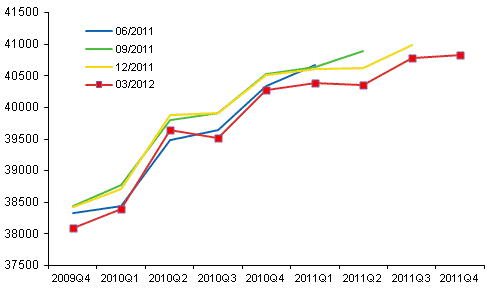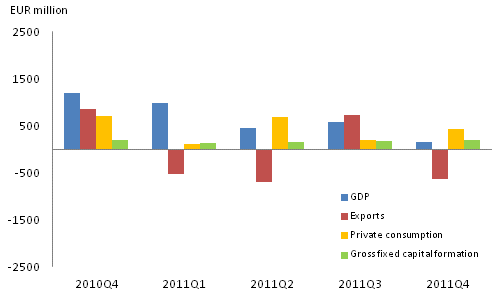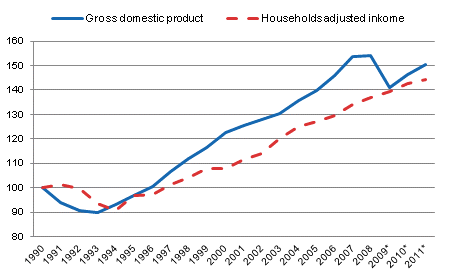1. Gross domestic product grew by 2.9 per cent in 2011
Corrected on 5 March 2012. The titling and order
of the figures in the review was corrected.
The volume of GDP grew by 2.9 per cent last year. Over the October
to December period, gross domestic product grew by 0.1 per cent
from the previous quarter. Compared with the last quarter of 2010,
GDP increased by 1.4 per cent. Revisions put the change in the
volume of GDP in the third quarter of 2011 at +1.1 per cent from
the previous quarter (was +0.9%) and at +3.3 per cent from twelve
months back (was +2.7%).
The relatively strong annual growth was mainly due to the low starting level in the first quarter of 2010. Compared with the level of the fourth quarter of 2010, economic growth remained modest last year, however. GDP grew strongest in the third quarter, but in the second quarter the seasonally adjusted volume of GDP even diminished slightly compared with the previous quarter.
The seasonally adjusted volume of gross domestic product reached last year the level of the early part of 2007, but was still at a clearly lower level than in 2008.Figure 1. Revisions - seasonally adjusted volume of GDP by release

According to the preliminary data compiled by Eurostat, in the last quarter of 2011 GDP contracted in the EU27 area by 0.3 per cent from the previous quarter but grew by 0.9 per cent from twelve months back.
1.1. Production
The volume of value added generated by all industries in the fourth quarter grew by 0.1 per cent from the previous quarter. Value added grew by 2.5 per cent in the whole of 2011. Value added was increased most by the metal industry, trade and business services (industries M to N) in 2011.
From October to December, the volume of value added in primary production decreased by 0.4 per cent from the previous quarter. In 2011, the volume of primary production grew by 3.5 per cent, however. Value added in agriculture increased by 6.7 per cent. In forestry, value added went up by 1.8 per cent last year.
In the fourth quarter, the volume of total manufacturing (industries B to E) went up by 0.4 per cent from the previous quarter. Value added fell by 7.4 per cent in the forest industry but grew by 3.4 per cent in the metal industry. Value added in the electrical and electronics industry went up by 4.3 per cent. From October to December, the volume of value added in construction increased by 2.3 per cent from the previous quarter.
In the whole of 2011, the volume of value added in manufacturing went up by 1.9 per cent. Value added in the forest industry went down by 1.1 per cent. In the metal industry, value added grew by 8.6 per cent. Value added in the electrical and electronics industry decreased by 3.4 per cent. Value added in construction grew by 3.8 per cent from the previous year.
From October to December, the volume of value added in service industries increased by 0.5 per cent from the previous quarter. Trade went up by 1.3 per cent and transport services by 0.9 per cent. Real estate activities (L) grew by 0.3 per cent and business services (M to N) likewise by 0.3 per cent.
In the whole of 2011, the volume of value added in service industries went up by 2.6 per cent. In trade, value added grew by 4.1 per cent and in transport services by 3.5 per cent. Real estate activities (L) increased by two per cent and business services (M to N) by as much as 7.1 per cent. Value added in financial intermediation and insurance fell slightly last year.
1.2. Imports, exports, consumption and investments
In 2011, demand in the national economy was boosted by private consumption, investments and change in inventories.
Figure 2. GDP and expenditure components, change from previous quarter (seasonally adjusted, at current prices)

Over the October to December period, the volume of exports fell by 0.7 per cent from the previous quarter. Exports of goods decreased by 9.1 per cent but exports of services grew by 20 per cent from the previous quarter. The volume of exports decreased by 0.8 per cent over 2011. Exports of goods grew by 2.1 per cent, but exports of services fell by 8.6 per cent.
From October to December, the volume of imports grew by 3.8 per cent from the previous quarter. Imports of goods went up by 0.3 per cent and those of services by 6.7 per cent from the previous quarter. The volume of imports grew by 0.1 per cent over 2011. Imports of goods went up by 6.2 per cent, but imports of services contracted by 14.8 per cent.
In the last quarter, the volume of private consumption went up by 0.1 per cent from the previous quarter. The volume of public consumption expenditure grew by 0.2 per cent. In the whole of 2011, the volume of private consumption increased by 3.3 per cent and that of public consumption expenditure by 0.8 per cent.
In the last quarter, the volume of investments grew by 0.4 per cent from the previous quarter. Construction investments increased by 0.2 per cent. The volume of investments in machinery, equipment and transport equipment grew by three per cent.
The volume of investments went up by 4.6 per cent in 2011. Investments in residential buildings increased by 4.4 per cent and investments in non-residential buildings by six per cent. The volume of civil engineering investments contracted by two per cent. The volume of investments in machinery, equipment and transport equipment grew by 12.1 per cent. Other investments, mainly consisting of software investments, contracted by 10.8 per cent.
1.3. Employment
The number of employed persons grew by 0.3 per cent in the fourth quarter. The number of hours worked in the national economy increased by 0.4 per cent from the previous quarter. In the whole of 2011, the numbers of persons employed and hours worked went up by 1.2 per cent.
Labour productivity, or the volume of gross value added per hour worked, increased by 1.3 per cent last year, but still remained over one per cent lower than in 2007.
According to Statistics Finland’s Labour Force Survey, the rate of unemployment in the October to December period was 6.9 per cent. In the corresponding period of 2010, it stood at 7.4 per cent. The unemployment rate for the whole of 2011 was 7.8 per cent.
1.4. Prices rose faster than before
The economy’s overall price level is estimated to have risen by 3.6 per cent last year as measured by the GDP price index. Prices rose faster than in the past few years.
Last year, the Consumer Price Index rose by 3.4 per cent, but the price index of household consumption expenditure in National Accounts went up by 3.0 per cent. In National Accounts, the prices of housing services are measured with changes in market rents, whereas the Consumer Price Index also takes into consideration all expenditure of owner-occupied housing. The methods used in National Accounts and in the Consumer Price Index for measuring development in the prices of insurance and financial intermediation services also deviate from each other.
The terms of trade weakened further, because import prices of goods and services rose by 7.6 per cent and export prices less, by 4.7 per cent.
1.5. National income grew by 1.4 per cent in real terms
Net national income grew by 6.5 per cent in nominal terms and by 1.4 per cent real terms last year, and was EUR 30,400 per capita. Last year, Finland’s gross national income was EUR 194 billion, or EUR two billion more than GDP. Gross national income grew by 1.3 per cent in real terms, i.e. slightly less than gross domestic product because the terms of trade weakened and net primary income from abroad decreased.
Households’ wage and salary income went up by 4.7 per cent and employers’ social insurance contributions by 0.6 per cent. Compensations of employees increased by a total of four per cent and their share of the national income contracted to 58.8 per cent. The respective proportion in the previous year was 60.2 per cent. Property and entrepreneurial income in the national economy increased by 8.5 per cent and their share of the national income stood at 26.4 per cent. The corresponding proportion was 25.9 per cent in the year before.
1.6. Non-financial corporations’ profits grew
Non-financial corporations' operating surplus describing profits from their actual operations went up by 15 per cent in nominal terms from the previous year. Their entrepreneurial income grew by 5.5 per cent but was still clearly lower than in the peak year of 2007. Entrepreneurial income also takes into consideration property income and paid interests and corresponds roughly with profit before payment of taxes and dividends.
Non-financial corporations paid 14 per cent more direct taxes and 16 per cent more dividends than in the year before.
Non-financial corporations’ net lending, or financial position, showed a surplus of EUR 5.2 billion, as against EUR 9.3 billion in the previous year. This was influenced by that enterprises' fixed investments in Finland started to grow last year, up by 8.2 per cent in nominal terms. Inventories also grew.
Financial corporations' interest income (financial intermediation services in-directly measured) went up but their commission income remained on level with the previous year. The credit and deposit stock continued to increase and the level of interest rates was higher than in the year before. The finan-cial position of insurance and financial corporations showed a surplus of EUR 1.6 billion.
1.7. General government deficit 0.5 per cent of gross domestic product
Last year, the financial position of central government showed a notable deficit for the third successive year. The deficit was EUR six billion, while one year before it was EUR ten billion. The growth in tax revenue particu-larly lowered the deficit.
State revenues from taxes went up by over 13 per cent. The revenue from direct taxes grew most, particularly increased income taxes paid by households on capital and earned income. The corporation tax revenue also went up. The revenue from indirect taxes grew due to increases in energy taxes and value added tax.
Current transfers to local government (incl. repayments of value added tax) went up by 3.6 per cent. Current transfers to social security funds remained on level with the previous year. The final consumption expenditure of central government grew by 1.4 per cent in nominal terms whereas investments decreased by nearly 13 per cent.
The deficit of municipalities and joint municipal boards was EUR 0.8 billion, slightly more than in the year before. Municipalities' tax income grew by 3.4 per cent. Final consumption expenditure went up by 4.4 per cent in nominal terms and investments are estimated to have grown by 6.8 per cent.
The financial position of employment pension funds remained on level with the previous year, showing a surplus of EUR 5.3 billion. The revenue from pension contributions and property income grew by roughly the same amount as paid employment pensions. Value changes in investments are not taken into consideration in the financial position. The finances of other social security funds were in balance.
Non-financial corporations’ net lending, or financial position, showed a deficit of EUR 1.5 billion, while the deficit was EUR 5.1 billion in the previous year. The so-called EDP deficit defined in the European Union's Growth and Stability Pact totalled EUR 0.9 billion, or 0.5 per cent of gross domestic product. It differs from general government net lending in that it also takes into account the effect of swap agreements on interest expenses.
The so-called EDP debt, or consolidated gross debt, of general government grew to over EUR 93 billion. Relative to GDP, it increased to 48.6 per cent, i.e. by 0.2 percentage points. Statistics Finland will publish the deficit and debt data that must be reported to the EU Commission on 30 March 2012. The deficit and debt data published here may become revised in that connection.
The proportion of public expenditure of gross domestic product was 54 per cent. In the previous year, the proportion was 55.5 per cent.
The tax ratio, or the proportion of taxes and statutory social security contributions of GDP, rose to 42.9 per cent last year. In the previous year the tax ratio was 42.3 per cent. The amount of taxes for the first time exceeded the level of 2008 prior to the economic downturn.
1.8. Households' real income grew further
Households’ disposable income grew by 4.4 per cent in nominal terms and by 1.4 per cent in real terms. Households’ adjusted disposable income in-creased by 4.3 per cent in nominal terms and by 1.3 per cent in real terms. Adjusted income also takes into consideration the individual services that general government and organisations produce for households, such as educational, health and social services.Figure 3. The real development of gross domestic product (unbroken line) and households' adjusted disposable income (broken line), 1990=100

Wages and salaries received by households went up by 4.7 per cent and social benefits by 2.9 per cent. Wage and salary income was put up by risen average earnings and slight improvement in employment. Households’ property and entrepreneurial income went up by 7.4 per cent.
Direct taxes paid by households increased by 7.2 per cent and consumption expenditure by 6.6 per cent. Because consumption expenditure grew more than disposable income, the savings ratio, or savings relative to disposable income, diminished to 1.5 per cent.
Households’ fixed investments went up by 9.3 per cent as housing construction increased further. Households’ financial position showed a deficit of EUR 4.7 billion.
Households’ indebtedness rate is estimated to have been 114.4 per cent at the end of last year, in other words, it grew by one percentage point over the year. The indebtedness rate expresses the ratio between the loans and annual disposable net income in accordance with financial accounts.
1.9 Next revisions in June and July 2012
Data concerning the first quarter of 2012 will be released on 5 June 2012. National Accounts for 2011 with more detailed data contents will be released on 12 July 2012. At the same time, the data for 2009 and 2010 will be revised.
These preliminary data are based on the information on economic development available by 24 February 2012. Methodological descriptions of National Accounts can be found on Statistics Finland’s website at : http://tilastokeskus.fi/til/ntp/men_en.html . and http://tilastokeskus.fi/til/vtp/men_en.html
Source: National Accounts 2011, 4th quarter. Statistics Finland
Inquiries: Pasi Koikkalainen 09 1734 3332, Samu Hakala 09 1734 3756, kansantalous.suhdanteet@stat.fi
Director in charge: Ari Tyrkkö
Updated 2.3.2012
Official Statistics of Finland (OSF):
Quarterly national accounts [e-publication].
ISSN=1797-9765. 4th quarter 2011,
1. Gross domestic product grew by 2.9 per cent in 2011
. Helsinki: Statistics Finland [referred: 8.1.2026].
Access method: http://stat.fi/til/ntp/2011/04/ntp_2011_04_2012-03-02_kat_001_en.html

